语言学 考研真题
- 格式:doc
- 大小:618.50 KB
- 文档页数:79
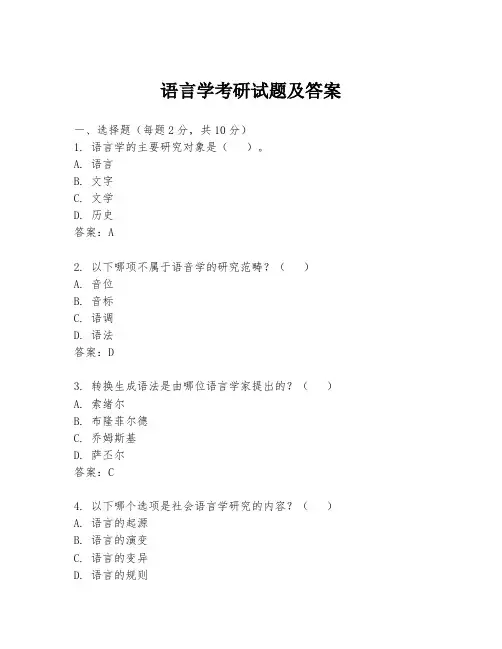
语言学考研试题及答案一、选择题(每题2分,共10分)1. 语言学的主要研究对象是()。
A. 语言B. 文字C. 文学D. 历史答案:A2. 以下哪项不属于语音学的研究范畴?()A. 音位B. 音标C. 语调D. 语法答案:D3. 转换生成语法是由哪位语言学家提出的?()A. 索绪尔B. 布隆菲尔德C. 乔姆斯基D. 萨丕尔答案:C4. 以下哪个选项是社会语言学研究的内容?()A. 语言的起源B. 语言的演变C. 语言的变异D. 语言的规则答案:C5. 语言接触导致的语言变化称为()。
A. 语言演变B. 语言借用C. 语言混合D. 语言分化答案:B二、填空题(每题2分,共10分)1. 语言学的三个基本分支是语音学、______和句法学。
答案:语法学2. 语言的最小意义单位是______。
答案:语素3. 一种语言的音位系统称为该语言的______。
答案:音系4. 语言的规则性体现在______。
答案:语法5. 语言的交际功能包括表达、______和指示。
答案:指称三、简答题(每题10分,共20分)1. 简述语言的任意性原则。
答案:语言的任意性原则指的是语言符号的音义结合是任意的,即语言符号的音与义之间没有自然的、必然的联系,而是由社会约定俗成的。
2. 描述语言的双重性。
答案:语言的双重性指的是语言既有形式又有内容。
形式指的是语言的音位、词汇、句法等结构;内容指的是语言所表达的意义和信息。
四、论述题(每题20分,共40分)1. 论述语言的交际功能。
答案:语言的交际功能是指语言在人际交流中的作用,主要包括以下几个方面:表达功能,即通过语言来表达个人的思想、情感和意愿;指称功能,即通过语言来指称或描述客观世界的事物和现象;社交功能,即通过语言进行社会交往,建立和维护人际关系;思维功能,即通过语言进行思考和认识世界。
2. 论述语言的演变过程。
答案:语言的演变过程是一个复杂且漫长的历史过程,包括语音、词汇、语法等方面的变化。
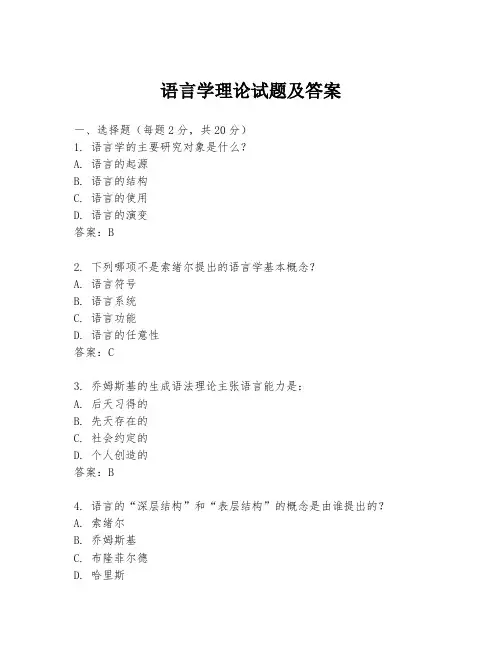
语言学理论试题及答案一、选择题(每题2分,共20分)1. 语言学的主要研究对象是什么?A. 语言的起源B. 语言的结构C. 语言的使用D. 语言的演变答案:B2. 下列哪项不是索绪尔提出的语言学基本概念?A. 语言符号B. 语言系统C. 语言功能D. 语言的任意性答案:C3. 乔姆斯基的生成语法理论主张语言能力是:A. 后天习得的B. 先天存在的C. 社会约定的D. 个人创造的答案:B4. 语言的“深层结构”和“表层结构”的概念是由谁提出的?A. 索绪尔B. 乔姆斯基C. 布隆菲尔德D. 哈里斯答案:B5. 语言的“同义异构”现象是指:A. 同一意义的不同表达方式B. 不同意义的相同表达方式C. 同一表达方式的不同意义D. 不同表达方式的相同意义答案:A6. 语言的“语境”指的是:A. 语言的内部结构B. 语言的外部环境C. 语言的使用者D. 语言的规则答案:B7. 语言的“语域”通常指的是:A. 语言的地域分布B. 语言的交际场合C. 语言的历史发展D. 语言的语法规则答案:B8. 语言的“语用学”研究的是:A. 语言的发音B. 语言的意义C. 语言的用法D. 语言的演变答案:C9. 语言的“语料库”是指:A. 语言的数据库B. 语言的规则集C. 语言的样本集D. 语言的词汇表答案:C10. 语言的“方言”是指:A. 同一语言的不同变体B. 不同语言的相似形式C. 同一语言的相同形式D. 不同语言的相同变体答案:A二、填空题(每题2分,共20分)1. 语言学的四大分支包括语音学、语法学、语义学和______。
答案:语用学2. 语言的“能指”指的是语言符号的______部分,而“所指”指的是语言符号的______部分。
答案:形式;意义3. 语言的“同音词”是指发音相同但______不同的词。
答案:意义4. 语言的“词缀”是指可以附加在词根上的______或______。
答案:前缀;后缀5. 语言的“句法”研究的是词、短语和句子的______。
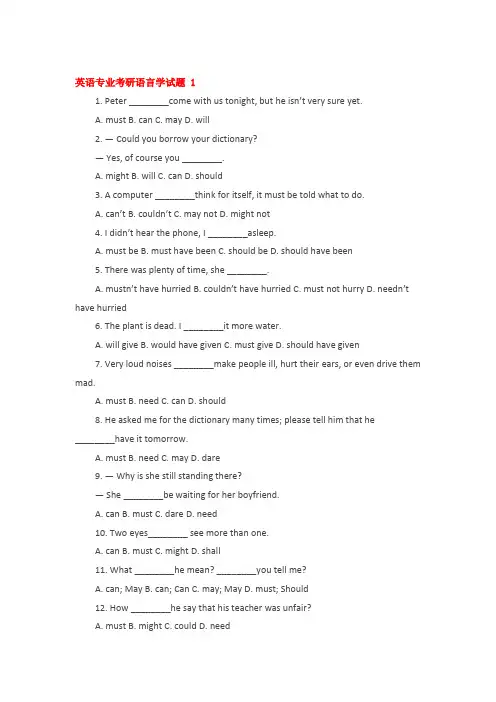
英语专业考研语言学试题 11. Peter ________come with us tonight, but he isn’t very sure yet.A. mustB. canC. mayD. will2. — Could you borrow your dictionary?— Yes, of course you ________.A. mightB. willC. canD. should3. A computer ________think for itself, it must be told what to do.A. can’tB. couldn’tC. may notD. might not4. I didn’t hear the phone, I ________asleep.A. must beB. must have beenC. should beD. should have been5. There was plenty of time, she ________.A. mustn’t have hurriedB. couldn’t have hurriedC. must not hurryD. needn’t have hurried6. The plant is dead. I ________it more water.A. will giveB. would have givenC. must giveD. should have given7. Very loud noises ________make people ill, hurt their ears, or even drive them mad.A. mustB. needC. canD. should8. He asked me for the dictionary many times; please tell him that he________have it tomorrow.A. mustB. needC. mayD. dare9. — Why is she still standing there?— She ________be waiting for her boyfriend.A. canB. mustC. dareD. need10. Two eyes________ see more than one.A. canB. mustC. mightD. shall11. What ________he mean? ________you tell me?A. can; MayB. can; CanC. may; MayD. must; Should12. How ________he say that his teacher was unfair?A. mustB. mightC. couldD. need13. It ________be very cold in this part.A. canB. oughtC. shallD. dare14. I’d like to ask a question if I ________.A. mustB. willC. mayD. might15. Even in summer the temperature ________suddenly drop below freezing.A. mightB. oughtC. mustD. need16. He decided to join the army so that he ________defend the country.A. may helpB. might helpC. helpsD. helped17. You ________always be talking like that.A. mightn’tB. mayn’tC. can’tD. mustn’t18. The car ________have broke down just when we were about to start off.A. mustB. couldC. mightD. should19. You ________see him while he is in hospital.A. have betterB. had betterC. would ratherD. had to20. There is a fine sunset; it ________to be a fine day tomorrow.A. oughtB. shouldC. has toD. has better21. You are his father, you ________take care of him.A. mightB. oughtC. ought toD. are able to22. That’s all. It ________be talked about any more.A. needn’tB. mightn’tC. darn’t toD. needn’t to23. The question ________discussing.A. needsB. needC. can beD. must be24. He ________even look out of the window.A. daren’tB. daresn’tC. dared not toD. dares not25. I’m so hungry that I ________find something to eat.A. have toB. wouldC. mayD. can26. All the students ________do their best for the modernization of our country.A. canB. shouldC. mayD. might27. You ________be careful with your homework.A. mustB. have toC. mayD. are used to28. It is getting darker. You ________not go home.A. had betterB. have betterC. would ratherD. would like29. I ________what happened to our school.A. would like knowB. would like to knowC. would like knowingD. would like that I know30. — Would you mind my changing the plan?— ________.A. Oh, no, pleaseB. Yes, I mind notC. No, I wouldD. Yes, I will31. — It ________ be Jack who is in the library.—I’m sure it ________be him, I saw him off at the railway station just two days ago.A. can’t; can’t eB. must; mustn’tC. must; can’tD. can’t; mustn’t32. I ________tell her the truth about his marriage.A. can’t helpB. can’t butC. may not helpD. mustn’t but33. Since she is angry, we ________.A. had better to leave her alongB. should leave her aloneC. would rather to leave her aloneD. must leave her alone34. Look! What you’ve done to me. You ________more careful.A. maybeB. had toC. should have beenD. would be35. ________read the letter for you?A. Would you like meB. Do you want meC. Will you mind meD. Shall I36. He promised he ________not make such silly mistakes.A. wouldB. shouldC. mightD. could37. ________it be true that his father will go abroad?A. CanB. MayC. NeedD. Should38. Those streams are so small that they ________be shown in the maps.A. mustn’tB. may notC. can’tD. may39. — May I use your bike?— ________.A. No, you may notB. No, you mustn’tC. No, you won’tD. Sorry, I’m afraid not40. — Must I write to her?— No, you ________.A. mustn’tB. shouldn’tC. can’tD. don’t have to41. — Need I start tonight?— Yes, you ________.A. doB. needC. mustD. may42. The old man ________sit for hours watching the ships.A. wouldB. shouldC. was used toD. would rather to43. If the telephone ________ring, please wake me up.A. wouldB. shouldC. willD. might44. I wish they ________stop making remarks about me.A. wouldB. willC. shouldD. shall45. You’re thirsty, aren’t you? ________he get some coffee?A. DoesB. ShallC. WouldD. Let46. Which of the following is wrong?A. That may be true.B. That might be true.C. That can be true.D. That could be true.47. — Would you lend me some money?— Yes, I ________.A. wouldB. willC. canD. may48. He ________ swimming when he was young.A. was used to goB. got used to goC. used to goingD. used to go49. You say you ________ not do it, but I say you ________do it.A. will; shallB. shall; shallC. shall; willD. will; will50. You ________out yesterday without a coat. No wonder you caught cold.A. should have goneB. shouldn’t have goneC. could not have goneD. might have gone51. He ________the 8:30 train because he didn’t leave home until 9:00.A. can’t catchB. couldn’t catchC. may notD. can’t have caught52. You ________us this because we had more than enough.A. needn’t bringB. needn’t have broughtC. mustn’t bringD. couldn’t have brought53. — He learnt the language in three months.— He ________very hard.A. must workB. might have workedC. must have workedD. might work54. — Who told you my telephone number?—I don’t remember. It ________Mary.—It can’t be Mary, she doesn’t know it.A. may have beenB. can have beenC. must beD. can be55. You ________him, why didn’t you?A. ought to thankB. ought have thankedC. ought to have thankedD. ought thank56. I ________have arrived a little earlier, but my car broke down.A. shouldB. couldC. canD. can’t57. — ________we go out for a walk?—Great. Let’s goA. ShallB. WillC. MayD. Should58. Though she was seriously ill, she ________ complete the work in time.A. wouldB. was able toC. was possible toD. might59. — Would you like to play chess with me?— Yes, ________.A. I’dB. I wouldC. I’d likeD. I’d like to60. Tom is late. He ________the wrong bus.A. must takeB. must have takenC. might takeD. could take英语专业考研语言学试题 21. Charles Babbage is generally considered ________the first computer.A. to have inventedB. inventingC. to inventD. having invented2. Little Jim should love ________to the theatre this evening.A. to be takenB. to takeC. being takenD. taking3. — I usually go there by train.— Why not ________by boat for a change?A. to try goingB. trying to goC. to try and goD. try going4. John was made ________the truck for a week as a punishment.A. to washB. washingC. washD. to be washing5. She reached the top of the hill and stopped ________on a big rock by the side of the path.A. to have restedB. restingC. to restD. rest6. She pretended________ me when I passed by.A. not to seeB. not seeingC. to not seeD. having not seen7. Though he had often made his sister ________, today he was made________by his sister.A. cry; to cryB. crying; cryingC. cry; cryingD. to cry; cry8. Tell him ________the window.A. to shut notB. not to shutC. to not shutD. don’t’ shut9. ________her sick to think of the matter.A. That madeB. That causedC. It madeD. It caused10. The woman’s job is ________after the disable children.A. lookB. looksC. lookedD. to look11. She ________to ________everything.A. demanded; tellB. demanded; be toldC. required; tellD. required; be told12. It’s time ________our league meeting.A. to beginB. beginningC. that we beginD. that we’ll begin13. That day I was the last one ________the experiment.A. madeB. makingC. to makeD. having made14. I’m hungry. Get me something ________.A. to be eatenB. to eatC. eatingD. to be eating15. Would you ________me to show you around the place?A. letB. likeC. mindD. care16. She is said ________the necklace.A. that she lostB. that she has lostC. to loseD. to have lost17. What do you think is the best way ________the problem?A. to settlingB. in which settlingC. to settleD. settling18. You are ________retell the story.A. oughtB. ought toC. expectingD. expected to19. I didn’t want the problem ________again.A. to raiseB. to be raisedC. being raisedD. be raised20. Have you had the nurse ________your son’s temperature?A. to takeB. takingC. takeD. taken21. First we should find a hotel ________for the night.A. to put up at itB. in order to put up atC. at where to put upD. at which to put up22. ________wake me up when you come in.A. You’d better not toB. You’d better notC. You hadn’t better toD. You hadn’t better23. I don’t think you need ________ today.A. to leaveB. to be leavingC. leavingD. being left24. We have been looking for the girl all the morning, but she is no where________.A. to seeB. to be seenC. being seenD. seen25. He should ________for what he has done.A. praiseB. be praisedC. have praisedD. to be praised26. He felt a stone ________his back.A. hittingB. to hitC. hittedD. hit27. I hurried to school, only ________out it was Sunday.A. findB. to findC. foundD. would find28. Here are some exercises that need________ after class.A. doneB. to be doneC. being doneD. to do29. I’ve been waiting for half an hour ________me the phone call.A. to giveB. for you givingC. of you to giveD. for you to give30. Everything ________smoothly.A. seems goingB. seems to be goingC. is seeming to goD. is seeming to be going31. It was thoughtful ________us the map of the city.A. of you to sendB. for you to sendC. of you sendingD. for you sending32. You are fortunate ________as a member of the club.A. being acceptedB. to acceptC. To have acceptedD. to have been accepted33. ________wasn’t pleasant ________up so early.A. He; to wakeB. He; to be wakenC. It; of him to wakeD. It; to be woken34. I find these problems are easy________.A. to work outB. to be worked outC. in working outD. to be worked them out35. How rude ________him ________a child like that.A. of; to treatB. for; to treatC. of; is to treatD. for; is to treat36. It was stupid ________him ________attend the lecture.A. of; to notB. of; not toC. for; to notD. for; not to37. It was impossible ________lost time to ________.A. for; make upB. of; make upC. for; be made upD. of; be made up38. The shoes are too large ________.A. to me to wearB. for me to wearC. to me to be wornD. for me to be worn39. ________was sorry________ made such a silly mistake.A. It; to haveB. It; havingC. I ; to haveD. I; having40. I’ll be delighted ________.A. when I’ll see you againB. to see you againC. that I see you againD. to have seen you again41. He was ________tired ________any further.A. too; walkingB. too; to walkC. so; walkingD. so; to walk42. Will you be ________kind ________make tea for me?A. so; toB. fairly; toC. so; as toD. fairly; as to43. The chair looks rather hard, but in fact it is very comfortable to ________.A. sitB. sit onC. be satD. be sat on44. I ________how to answer the question.A. puzzleB. am puzzlingC. have puzzledD. am puzzled45. Have you decided ________the party?A. whether you holdB. why to holdC. whether to holdD. if to hold46. He doesn’t know ________to stay or not.A. ifB. eitherC. neitherD. whether he ought47. Last summer I took a course on ________.A. how to make dressesB. how dresses be madeC. how to be made dressesD. how dresses to be made48. He hesitated ________ the medicine.A. takingB. about to takeC. whether he takeD. whether to take49. How do the birds know exactly ________ direction ________?A. which, flyingB. which; to fly toC. in which; to flyD. X; flying to50. —I don’t know ________with the problem.— Why not ________your teacher for advise?A. what to do; to askB. how to do; to askC. what to do; askD. how to do; ask51. I think he should get a job, but you can’t force him ________ if he’s not ready ________.A. to get; toB. to get; XC. to; X D; to; to do52. — Would you like to go to the ball?— Yes, ________.A. I’dB. I’d likeC. I’d like toD. I’d like to go53. —Aren’t you in charge of this?— No, and I ________.A. don’t wantB. don’t want toC. don’t want to be D am not54. ________the truth, I don’t want to go.A. To tellB. TellC. TellingD. In order to tell55. I’d rather read something at home than ________to the park in such weather.A. goB. to goC. goingD. went56. We could do nothing but ________Father for help.A. askB. askingC. to askD. asked57. He wanted nothing but ________in the corner.A. seatB. be seatedC. be seatD. to be seated58. It ________about two years________ such a big dam.A. takes; in buildingB. takes; to buildC. needs; in buildingD. needs; to build59. How much did ________cost ________the house?A. it; in rebuildingB. he; in rebuildingC. it; to rebuildD. he; to rebuild60. ________requires patience ________a good nurse.A. She; to beB. she; if she isC. It; to beD. It; if she is。
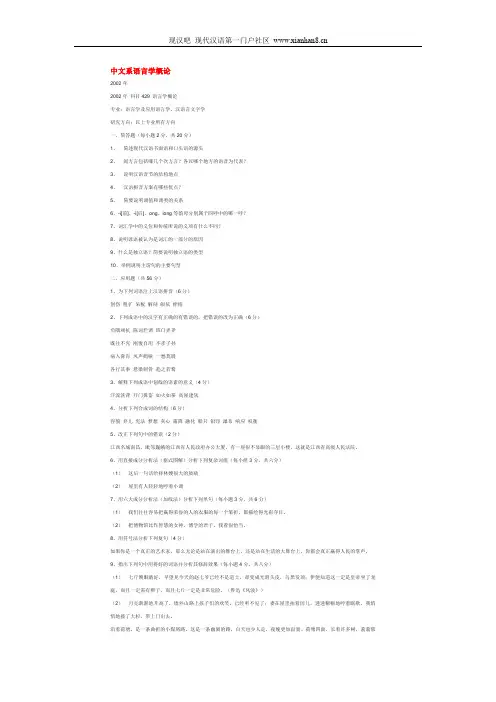
中文系语言学概论2002年2002年科目429 语言学概论专业:语言学及应用语言学、汉语言文字学研究方向:以上专业所有方向一、简答题(每小题2分,共20分)1、简述现代汉语书面语和口头语的源头2、闽方言包括哪几个次方言?各以哪个地方的语音为代表?3、说明汉语音节的结构地点4、汉语拼音方案有哪些优点?5、简要说明调值和调类的关系6、-i[前]、-i[后]、ong、iong等韵母分别属于四呼中的哪一呼?7、词汇学中的义位和传统所说的义项有什么不同?8、说明谚语被认为是词汇的一部分的原因9、什么是独立语?简要说明独立语的类型10、举例说明主谓句的主要句型二、应用题(共56分)1、为下列词语注上汉语拼音(6分)创伤粗犷呆板解剖皈依桎梏2、下列成语中的汉字有正确的有错误的,把错误的改为正确(6分)负隅顽抗陈词烂调班门弄斧既往不究刚愎自用不孝子孙病入膏肓风声鹤唳一愁莫展各行其事悬梁刺骨趋之若鹜3、解释下列成语中划线的语素的意义(4分)汗流浃背开门揖盗如火如荼高屋建瓴4、分析下列合成词的结构(6分)容貌弃儿宪法梦想灰心霜降融化船只铅印瀑布响应权衡5、改正下列句中的错误(2分)江西名城南昌,毗邻巍峨的江西省人民政府办公大厦,有一座很不显眼的三层小楼,这就是江西省高级人民法院。
6、用直接成分分析法(框式图解)分析下列复杂词组(每小组3分,共六分)(1)这后一句话给祥林嫂很大的鼓励(2)屋里有人轻轻地哼着小调7、用六大成分分析法(加线法)分析下列单句(每小题3分,共6分)(1)我们往往容易把赢得荣誉的人的衣服的每一个皱折,都描绘得光彩夺目。
(2)把博物馆比作智慧的女神、博学的君子,我看很恰当。
8、用符号法分析下列复句(4分)如果你是一个真正的艺术家,那么无论是站在演出的舞台上,还是站在生活的大舞台上,你都会真正赢得人民的掌声。
9、指出下列句中用得好的词语并分析其修辞效果(每小题4分,共八分)(1)七斤嫂眼睛好,早望见今天的赵七爷已经不是道士,却变成光滑头皮,乌黑发顶;伊便知道这一定是皇帝坐了龙庭,而且一定需有辫子,而且七斤一定是非常危险。

语言学考研真题及答案一、语音学部分以下是2019年语言学考研真题及答案的整理:题目一:下列哪个选项中的音素是塞音?A. [h]B. [p]C. [r]D. [m]答案:B. [p]题目二:下列哪个选项中的音素是元音?A. [s]B. [l]C. [i]D. [t]答案:C. [i]题目三:下列哪个选项中的音素是鼻音?A. [k]B. [n]C. [g]D. [w]答案:B. [n]二、语法学部分以下是2020年语言学考研真题及答案的整理:题目一:下列短语中,哪个可以作为主语?A. "在公园里跑步"B. "喜欢读书的人"C. "听音乐"D. "为他做饭"答案:B. "喜欢读书的人"题目二:下列短语中,哪个可以作为宾语?A. "开心地唱歌"B. "漂亮的花园"C. "给他礼物"D. "在海边散步"答案:C. "给他礼物"题目三:下列短语中,哪个可以作为定语?A. "跳舞的小孩"B. "在教室里学习"C. "大声地喊"D. "看电影"答案:A. "跳舞的小孩"三、语义学部分以下是2018年语言学考研真题及答案的整理:题目一:下列哪个词汇与“快乐”具有相似的意义?A. "悲伤"B. "生气"C. "开心"D. "愤怒"答案:C. "开心"题目二:下列哪个词汇与“大”具有相反的意义?A. "小"B. "长"C. "高"D. "短"答案:A. "小"题目三:下列哪个词汇与“美丽”具有近义词的关系?A. "丑陋"B. "普通"C. "漂亮"D. "丰富"答案:C. "漂亮"综上所述,以上是语言学考研真题及答案的简要整理。
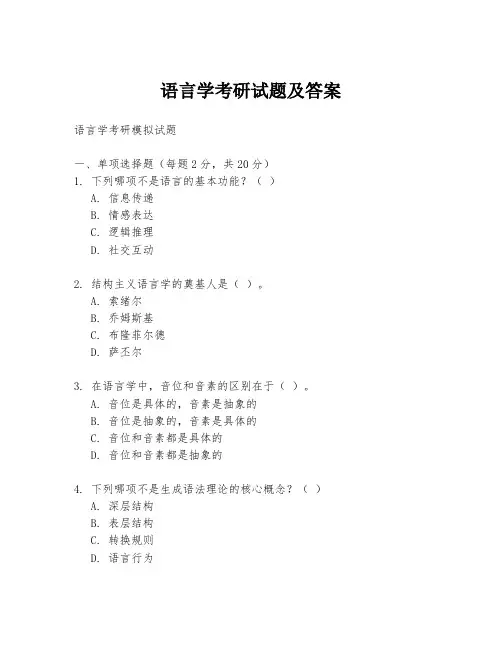
语言学考研试题及答案语言学考研模拟试题一、单项选择题(每题2分,共20分)1. 下列哪项不是语言的基本功能?()A. 信息传递B. 情感表达C. 逻辑推理D. 社交互动2. 结构主义语言学的奠基人是()。
A. 索绪尔B. 乔姆斯基C. 布隆菲尔德D. 萨丕尔3. 在语言学中,音位和音素的区别在于()。
A. 音位是具体的,音素是抽象的B. 音位是抽象的,音素是具体的C. 音位和音素都是具体的D. 音位和音素都是抽象的4. 下列哪项不是生成语法理论的核心概念?()A. 深层结构B. 表层结构C. 转换规则D. 语言行为5. 语言的任意性原则是由哪位语言学家提出的?()A. 索绪尔B. 乔姆斯基C. 布隆菲尔德D. 萨丕尔6. 在语义学中,词义的最小意义单位是()。
A. 语素B. 词汇C. 短语D. 句子7. 下列哪项不是社会语言学研究的内容?()A. 语言变异B. 语言与性别C. 语言与年龄D. 语言的生物学基础8. 语言的同化现象通常是指()。
A. 语言的消亡B. 语言的创新C. 语言的借用D. 语言的统一9. 下列哪项是语言接触的结果?()A. 语言的分化B. 语言的融合C. 语言的独立发展D. 语言的隔离10. 在语言学中,词汇-功能语法是由哪位学者提出的?()A. 韩礼德B. 乔姆斯基C. 布隆菲尔德D. 萨丕尔二、简答题(每题10分,共20分)1. 简述语言的萨丕尔-沃尔夫假说。
2. 描述一下什么是形态学,并给出一个例子。
三、论述题(每题30分,共60分)1. 论述语言的普遍语法理论及其对语言习得的影响。
2. 分析社会语言学中的“语言变异”现象,并讨论其对语言研究的意义。
参考答案:一、单项选择题1. C2. A3. B4. D5. A6. A7. D8. C9. B10. A二、简答题1. 萨丕尔-沃尔夫假说,又称为语言相对论,是由语言学家爱德华·萨丕尔和他的学生本杰明·李·沃尔夫提出的。

专八语言集锦(05年——14年专八真题及解析归纳)目录1、2005年 (1)2、2006年 (2)3、2007年 (4)4、2008年 (6)5、2009年 (8)6、2010年 (10)7、2011年 (11)8、2012年 (12)9、2013年 (13)10、2014年 (14)11、附加语言学考研题 (15)2005年38.(考查点:main branches of linguistics) Syntax is the study ofA. language functionsB. sentence structuresC. textual organizationD.word formation答案:B。
解析:Syntax is about principles of forming and understanding correct English sentences,是关于形成和理解正确英语句子的原则。
也就是句子结构。
故选择B。
39.(考察点:design features of language) Which of ale following is NOTa distinctive feature of human language?A. ArbitrarinessB. ProductivityC. Cultural transmissionD. Finiteness答案:D。
解析:题问下面四个选项中,哪一个不是人类语言的主要特征?除Finiteness(有限性)外,选项中的其它的三项Arbitrariness(任意性),Productivity(能产性)和Cultural transmission(文化传递性)在语言学概述部分都提到了。
故选择D。
40. (考察点:人物)The speech act theory was first put forward byA. John SearleB. John AustinC. Noam ChomskyD. M.A,K. Halliday答案:B。
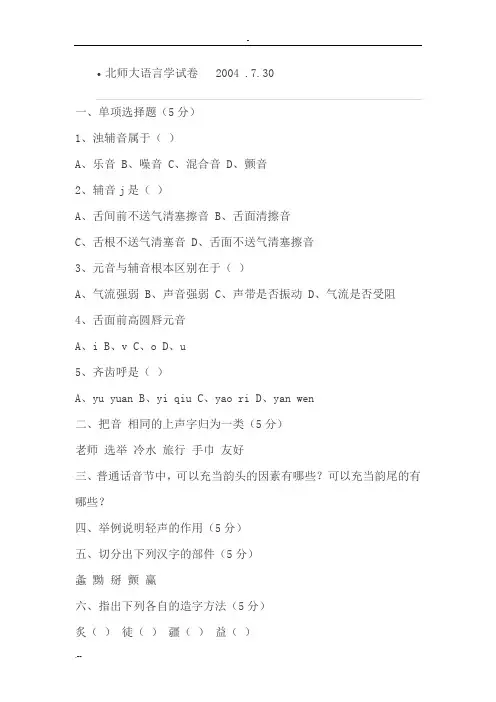
北师大语言学试卷 2004 .7.30一、单项选择题(5分)1、浊辅音属于()A、乐音B、噪音C、混合音D、颤音2、辅音j是()A、舌间前不送气清塞擦音B、舌面清擦音C、舌根不送气清塞音D、舌面不送气清塞擦音3、元音与辅音根本区别在于()A、气流强弱B、声音强弱C、声带是否振动D、气流是否受阻4、舌面前高圆唇元音A、iB、vC、oD、u5、齐齿呼是()A、yu yuanB、yi qiuC、yao riD、yan wen二、把音相同的上声字归为一类(5分)老师选举冷水旅行手巾友好三、普通话音节中,可以充当韵头的因素有哪些?可以充当韵尾的有哪些?四、举例说明轻声的作用(5分)五、切分出下列汉字的部件(5分)螽黝掰颤赢六、指出下列各自的造字方法(5分)炙()徒()疆()益()燕()母()戒()即()七、指出下列单纯词的类型(5分)叮咛()蝴蝶()镭射()尴尬()彷徨()八、下列各词中语素“风”有什么不同意义?(5分)风俗风琴作风西风学风九、指出下列词的基本义和转义(5分)海打气十、解释下列成语中加点语素的意义(5分)以邻为壑(壑,)不速之客(速,)不刊之论(刊,)不胫而走(胫,)脱颖而出(颖,)十一、你对词类划分的标准持什么看法?(5分)十二、请用层次分析法分析下列词组(5分)1、母亲那布满皱纹的慈祥的脸2、用中国乐器演奏的西洋乐曲3、世界珍稀动物熊猫的故乡中国4、到镇上粮食棉花收购站看一下市场情况十三、什么是主谓谓语句,主谓作宾句,双宾语句和兼语连谓套用的句子?请举例说明(10分)十四、修改下列病句,并说明错误的原因(10分)1、看了兰州市青年京剧团新编的京剧《南天柱》,在剧场的炽热的气氛里,使人感觉到剧情打动了观众的心。
2、这个被严重烧伤,生命垂危的病人,由于各科医生的紧密合作,全力抢救,终于挽救了他的生命。
3、由于曹雪芹所处的时代和出身阶级的局限,不能不在他的作品中有所反映。
4、作为一个翻译工作者,一方面要学习好外语,一方面要学好本民族的语言也是非常重要的。
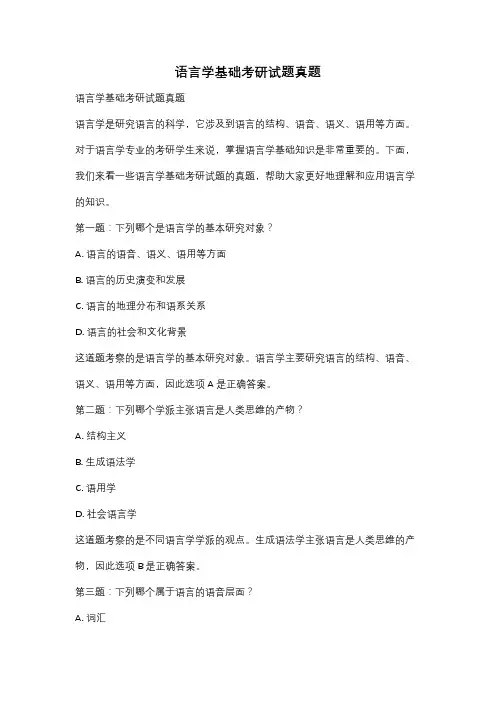
语言学基础考研试题真题语言学基础考研试题真题语言学是研究语言的科学,它涉及到语言的结构、语音、语义、语用等方面。
对于语言学专业的考研学生来说,掌握语言学基础知识是非常重要的。
下面,我们来看一些语言学基础考研试题的真题,帮助大家更好地理解和应用语言学的知识。
第一题:下列哪个是语言学的基本研究对象?A. 语言的语音、语义、语用等方面B. 语言的历史演变和发展C. 语言的地理分布和语系关系D. 语言的社会和文化背景这道题考察的是语言学的基本研究对象。
语言学主要研究语言的结构、语音、语义、语用等方面,因此选项A是正确答案。
第二题:下列哪个学派主张语言是人类思维的产物?A. 结构主义B. 生成语法学C. 语用学D. 社会语言学这道题考察的是不同语言学学派的观点。
生成语法学主张语言是人类思维的产物,因此选项B是正确答案。
第三题:下列哪个属于语言的语音层面?A. 词汇B. 语法C. 语音D. 语义这道题考察的是语言的不同层面。
语音层面主要研究语言的音素、音节等方面,因此选项C是正确答案。
第四题:下列哪个是语言的基本单位?A. 词B. 句子C. 短语D. 字母这道题考察的是语言的基本单位。
句子是语言的基本单位,因此选项B是正确答案。
第五题:下列哪个学派主张语言是社会文化的产物?A. 结构主义B. 生成语法学C. 语用学D. 社会语言学这道题考察的是不同语言学学派的观点。
社会语言学主张语言是社会文化的产物,因此选项D是正确答案。
通过以上几道试题的解答,我们可以看出语言学的基础知识包括语言的结构、语音、语义、语用等方面的研究,同时还涉及到语言的历史演变和发展、地理分布和语系关系、社会和文化背景等方面的内容。
掌握这些基础知识对于语言学专业的考研学生来说是非常重要的。
除了掌握基础知识,考生还需要了解不同语言学学派的观点和理论。
不同的学派对于语言的起源、发展和使用等方面有不同的解释和研究方法。
对于考生来说,了解这些不同的观点和理论,可以帮助他们更好地理解和应用语言学的知识。

重庆大学外国语学院研究生考试试题(语言学概论)-(第一、二部分试题做在试题册上,第二部分写在空白答题纸上。
)Part I: Basic Concepts (20%)Briefly define the following terms in English.1. morphology2. diphthon3. compound sentence4. deep structure5. ellipsis6. semantics7. free variation8. co-operative principles9. prefix10. hyponymyPart II: Language Analysis (50%)2.1. Give the phonetic symbol for each of the following sounds together with an illustration of the use of the sound in an English word. You are required to give no less than three words for the illustration of each symbol.1) voiceless bilabial stop:______________________2) high back tense roundedvowel:___________________________3) voiced retroflex:___________________________-4) voiceless interdental fricative:_________________________5) high front tense unroundedvowel:_____________________________2.2. Indicate the position of main stress in each of the following words by writing an accent mark ( ) over the appropriate vowel symbol or symbols.1. apple2. baboon3. behest4. decent5. descent6. executive7. indiscriminate8. massage9. yesterday 10. zoological11. sagacity 12. neurologist 13. facetious 14. caress 15. Washingtonian2.3. Each of the following compounds is made up of two parts. How do the parts relate to each other? Two examples are given below: e.g. fleabite (a bite from a flea)bridcage (a cage for bird)1. bedside_________2. mailbox____________3. hardwood___________4. paintbrush________________5. password____________6. windowpane_________________7. outlaw____________8. nightfall_______________9. rainbow________________ 10. sunshine_________________ 2.4. There are ten sentences below, part of the sentence is underlined, read the underlined part carefully and identify its construction type and write the term (Modification, Predication, Complementation and Subordination) in the blank.One example is given:Example: John runs slowly. (Modification)1. Mary stood at the back. ( )2. Mary is a nurse. ( )3. Mary sings. (4. The old man likes to come here everyday. ( )5. I want to go. (6. Peter kissed Mary. (7. She cried when she fell down. (8. Jack sings but Mary dances. (9. I know where she is. ( )10. John is clever. ( )2.5. Choose from five diagrams, the one that illustrate the relationship among three given classes better than any other diagram offered. One example is given below:A) C) D) E)e.g. animal, vegetable, tiger (C)1. bachelors, men, tennis player ( )2. sparrows, birds, cats ( )3. people, scientists, Chinese (4. white-haired, doctor, woman ( )5. furniture, bed, chair ( )6. baseball fans, artists, painters (7. frogs, mosquitoes, insects (8. varsity athletes, seniors, members of student honor society ( )9. octopi, porpoises, things live in the sea ( )10. wood, stone, pine (2.6 Explain the meaning of the underlined words in the following sentences. One example is given below:e.g. The judge gave orders to clear the court. (order the members of the public to leave)1. He did not know how to draw a cheque.___________________2. It falls to you to reorganize the footballteam.____________________3. The bill has twenty days to run.__________________4. Colors run in washing._______________________5. Where does the river take its rise?_____________________6. He who cannot take a joke should not makeone.______________________7. The company cleared $5,000 on its cotton exports last season.__________________8. The flap of the envelope has comeunstuck._____________________9. They gave their enemy a good beating.____________________10. Where is this carpet to go?________________2.7. State, by writing a, b, c,d, etc. where the preposition underlined indicates.a. Positionb. Destinationc. Passaged. Orientatione. Resultative statef. Pervasive (static) stateg. Pervasive motion1. The monkeys disappeared through the window. (2. I went into the bathroom to get a drink of water. (3. I looked in the mirror and thought I had a monkey’s face. (4. A monkey was sitting on the edge of the bath. (5. It was squeezing toothpaste all over its chest. (6. I rushed out of the house, shouting for help. (7. Out of the house, I felt calmer. (8. I sent for the monkey-catcher, who lived across the river. (9. We ran behind the house and watched. (10. Paper lay scattered all over the floor. (2.8. Indicate by a, b, c, whether the object underlined in the following sentences is:a. affectedb. effectedc. locative1. Has anyone touched the television today? (2. Who is making all that noise? (3. We are just passing the Eiffel Tower. (4. Take the deep breath. (5. Somebody took my coat by mistake. (6. I climbed the hill as light fell short. (7. A gas leak can cause a serious explosion. (8. We have fought a good fight – and lost. (9. Have you dropped your handkerchief, my dear? (10. After that I paid her a visit every evening. (2.9. Give at least three verbs to illustrate each of the following types of speech acts.One example is given for each type.1. Assertives: assert, _________________________________2. Declarations: declare,___________________________________3. Directives: invite, _________________________________4. Commissives: commit,____________________________________5. Expressives: apologize, _________________________________ Part III: Detailed Discussion (30%)There are 4 given topics below. You may choose any three of them to give detailed discussion. (write your answer on the blank paper)1. What is communicative competence?2. What is indirect speech act?3. Use your own experience in learning English to show culture is very important in language learning.4. Can you give examples to illustrate the phenomena of the interlanguage in learning a foreign language?。
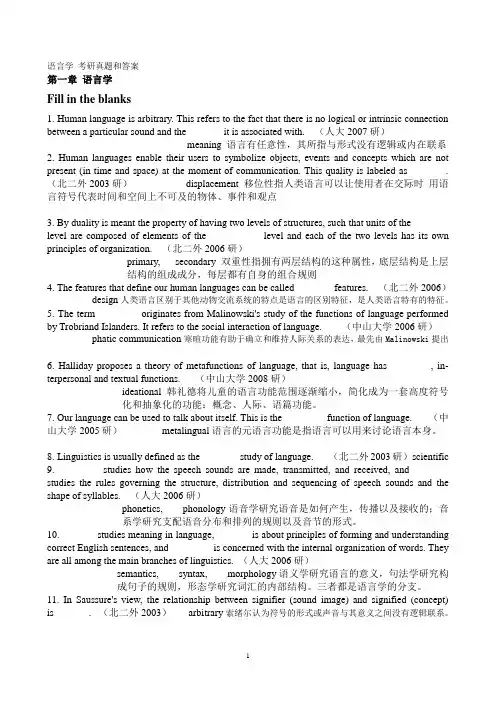
语言学考研真题和答案第一章语言学Fill in the blanks1. Human language is arbitrary. This refers to the fact that there is no logical or intrinsic connection between a particular sound and the _______it is associated with. (人大2007研)meaning 语言有任意性,其所指与形式没有逻辑或内在联系2. Human languages enable their users to symbolize objects, events and concepts which are not present (in time and space) at the moment of communication. This quality is labeled as _______. (北二外2003研)displacement 移位性指人类语言可以让使用者在交际时用语言符号代表时间和空间上不可及的物体、事件和观点3. By duality is meant the property of having two levels of structures, such that units of the _______ level are composed of elements of the __________ level and each of the two levels has its own principles of organization. (北二外2006研)primary, secondary 双重性指拥有两层结构的这种属性,底层结构是上层结构的组成成分,每层都有自身的组合规则4. The features that define our human languages can be called _______ features. (北二外2006)design人类语言区别于其他动物交流系统的特点是语言的区别特征,是人类语言特有的特征。
语言学考试试题及答案一、选择题(每题2分,共20分)1. 语言学是研究语言的科学,它包括以下哪些分支学科?A. 语音学B. 语法学C. 语义学D. 所有选项答案:D2. 下列哪个术语不是语言学的分支?A. 社会语言学B. 心理语言学C. 神经语言学D. 化学语言学答案:D3. 语言的最小意义单位是什么?A. 音素B. 词素C. 词D. 句子答案:B4. 以下哪个选项是语言的语音属性?A. 音高B. 音长C. 音色D. 所有选项答案:D5. 语言的语法规则可以是:A. 显性的B. 隐性的C. 两者都是D. 两者都不是答案:C6. 以下哪种语言现象不属于语言变异?A. 方言B. 社会方言C. 语言接触D. 语言消亡答案:D7. 语言的演变通常被认为是:A. 随机的B. 有目的的C. 无意识的D. 有意识的答案:C8. 语言接触可能导致:A. 语言融合B. 语言分离C. 语言借用D. 所有选项答案:D9. 语言的语用学研究的是:A. 语言的语境B. 语言的功能C. 语言的意义D. 所有选项答案:D10. 以下哪个术语不属于语义学研究的范围?A. 语义场B. 语义角色C. 语义关系D. 音位学答案:D二、填空题(每题2分,共20分)1. 语言的______属性包括音高、音长和音色。
答案:语音2. 语言的______属性包括语法、词汇和语义。
答案:结构3. 语言的______属性涉及语言的社会和文化方面。
答案:社会4. 语言学中的______理论认为语言是一系列规则的集合。
答案:形式主义5. 语言的______是语言学研究的基础单位。
答案:句子6. 语言的______是指语言在不同社会群体中的变体。
答案:变异7. 语言的______是指语言在不同地理区域的变体。
答案:方言8. 语言的______是指语言在不同时间的演变。
答案:历史9. 语言的______是指语言在不同语境中的使用。
答案:语用10. 语言的______是指语言的抽象意义。
北京师范大学一九九年攻读硕士学位研究生入学考试试题·语概·现汉专业:汉语言文字学研究方向:训诂学与汉语词汇学、汉字学、汉语语法学、修辞学考试科目:语言学概论及现代汉语语言理论部分(共50分)一、解释下列名词或术语(20分)语法范畴历史语言学结构语言学语义场音位二、回答下列问题(30分)1、“汉藏语系”与“印欧语系”是根据什么标准划分的?这两种语系的主要区别表现在哪些方面?2、怎样认识语言符号的“任意性”与“强制性”?3、按照功能分类法,世界文字大致可经划分为几种类型?现代汉字属于哪种类型?现代汉语部分(共50分)一。
、回答下列问题(20分)1、什么是“异读词”?它与多音多义字有何区别?2、现代汉字的标准化包括哪些内容?怎样进行现代汉字的整理和规范?3、什么是基本词汇?其主要特征有哪些?4、什么叫歧义句式?什么叫同义句式?安徽师范大学1996年招收研究生考题·语言学招生专业、研究方向:现代汉语考试科目:语言学基础一、解释下列术语:(17分)音位(3分)变词语素(3分)态(一种语法范畴)(3分)语言融合(4分)言内意外(4分)二、结合汉语词类的划分谈谈组合关系和聚合关系之间的联系。
(10分)三、元音和辅音有哪些区别?(6分)四、怎样确定音位的区别特征?请举例加以说明。
(12分)五、汉语中的助词“们”与英语里表示名词复数的“-6”相比有哪些不同?请举例说明。
(13分)六、语言的结构类型有哪四种?它们主要有哪些特点?(10分)七、结合同义词、反义词现象谈谈词的理性意义和附加意义(附加色彩)之间的关系。
(12分)八、外业词进入汉语以后会发生哪些变化?试举例说明。
(10分)安徽师范大学1994年招收研究生考题招生专业、研究方向:现代汉语考试科目:语言学基础一、简述语言系统中的组合关系和聚合关系。
(10分)二、人类语言和动物的交际方式的本质区别表现在哪几个方面?试简述之。
(12分)三、普通话音位系统的区别特征有哪几对?试举例说明。
语言学考研真题和答案第一章语言学Fill in the blanks1. Human language is arbitrary. This refers to the fact that there is no logical or intrinsic connection between a particular sound and the _______it is associated with. (人大2007研)meaning 语言有任意性,其所指与形式没有逻辑或内在联系2. Human languages enable their users to symbolize objects, events and concepts which are not present (in time and space) at the moment of communication. This quality is labeled as _______. (北二外2003研)displacement 移位性指人类语言可以让使用者在交际时用语言符号代表时间和空间上不可及的物体、事件和观点3. By duality is meant the property of having two levels of structures, such that units of the _______ level are composed of elements of the __________ level and each of the two levels has its own principles of organization. (北二外2006研)primary, secondary 双重性指拥有两层结构的这种属性,底层结构是上层结构的组成成分,每层都有自身的组合规则4. The features that define our human languages can be called _______ features. (北二外2006)design人类语言区别于其他动物交流系统的特点是语言的区别特征,是人类语言特有的特征。
英语语言学考研真题与典型题详解I. Fill in the blanks. 1. The features that define our human languages can be call ed ______ features. (北二外2006研)2. Linguistics is usually defined as the ______study of language. (北二外2003研)3. Language, broadly speaking, is a means of______ communication.4. In any language words can be used in new ways to mean new things and can be combined into innumerable sentences based on limited rules. This feature is usually ter med______5. Linguistics is the scientific study of______.6. Modern linguistic is______ in the sense that the linguist tries to discover whatlanguage is rather than lay down some rules for people to observe.7. One general principle of linguistic analysis is the primacy of ______ over writing.8. The branch of linguistics which studies the sound patterns of a language is called______. (北二外2003研)9. The branch of grammar which studies the internal structure of words is called______ . (北二外2004研)10. ______mainly studies the characteristics of speech sounds and provides methods for their description, classification and transcription. (北二外2005研)11. Semantics and ______investigate different aspects of linguistic meaning. (北二外2007研)12. In linguistics, ______ refers to the study of the rules governing the way wordsare combined to form sentences in a language, or simply, the studyof the formation as sentence. (中山大学2008研)13. ______can be defined as the study of language in use. Sociolinguistics, on the other hand, attempts to show the relationship between language and society.14. The branch of grammar which studies the internal structure of sentence is called_______. (北二外2008研)15. Saussure distinguished the linguistic competence of the speaker and the actual ph enomena or data of linguistics (utterances) as and . The former refers to the abstract linguisticlinguistic system shared by all the members of a speech community, and the latter is the concrete manifestation of language either through speech or through writing. (人大2006研)16. The description of a language as it changes through time is a ______ study.17. Linguistic potential is similar to Saussure’s langue and Chomsky’s______.18. One of the important distinctions in linguistics is ______ and parole. The formeris the French word for “language”,which is the abstract knowledge necessary for s peaking,listening,writing and reading. The latter is concerned about the actual use of language by peop le in speech or writing. Parole is more variable and may change according to contextu al factors.19. One of the important distinctions in linguistics is and performance. (人大2006研)20. Chomsky initiated the distinction between ______ and performances. (北二外2007研)II. Multiple Choice1.Which of the following is NOT a frequently discussed design feature? (大连外国语学院2008研)A. ArbitrarinessB. ConventionC. Dualityof the following words is entirely arbitrary? (西安交大2008研)A. treeB. crashC. typewriterD. bang3. A linguist regards the changes in language and languages use as______.A. unnaturalB. something to be fearedC. naturalD. abnormal4. Which of the following property of language enables language users to overcome thebarriers caused by time and place, due to this feature of language, speakers of a language are free to talk about anything in any situation?A. Transferability.B. Duality.C. Displacement.D. Arbitrariness:5. The study of physical properties of the sounds produced in speech is closely con nected with______. (大连外国语学院2008研)A. articulatory phoneticsB. acoustic phoneticsC. auditory phonetics6. Which of the following statements is true of Jacobson’s framework of language func tions?A. The referential function is to indulge in language for its own sake.B. The emo tive function is to convey message and information.C. The conative function is to clear up intentions, words and meanings.D. The phat ic function is to establish communion with others.of the following is a main branch of linguistics? (大连外国语学院2008研)A. MacrolinguisticsB. PsycholinguisticsC. Sociolinguistics8. ______ refers to the system of a language, i. e. the arrangement of sounds and w ords which speakers of a language have a shared knowledge of. (西安外国语学院2006研) A. Langue B. Competence C. Communicative competence D. Linguistic potentialstudy of language at one point in time is a _______ study. (北二外2010研)A. historicalB. synchronicC. descriptiveD. diachronic10. “An refer to Confucius even though he was dead 2,000 years ago. ”This shows that language has the design feature of _____.A. arbitrarinessB. creativityC. dualityD. displacement11. The function of the sentence “Water b oils at 100 degreeCentigrade”is .A. interrogativeB. directiveC. informativeD. performative is closely connected with ______. (大连外国语学院2008研) A. Langue B. Competence C. EticIII. True or False1. Onomatopoeic words can show the arbitrary nature of language. (清华2000研)2. Competence and performance refer respectively to a language user’s underlying knowle dge about the system of rules and the actual use of language in concrete situations.3. Language is a means of verbal communication. Therefore, the communication way usedby the deaf-mute is not language4. Arbitrariness of language makes it potentially cre ative, and conventionality of language makes a language be passed from generation to g eneration. As a foreign language learner, the latter is mere important for us.5. The features that define our human languages can be called DESIGN FEATURES. (大连外国语学院2008研)6. By diachronic study we mean to study the changes and development of language.7. Langue is relatively stable and systematic while parole is subject to personal and situational constraints.8. Language change is universal, ongoing and arbitrary.9. In language classrooms nowadays the grammar taught to students is basically descript ive, and more attention is paid to the developing learners’communicative skills.10. Language is a system of arbitrary, written signs which permit all the people ina given culture, or other people who have learned the system of that culture, to com municate or interact.11. Saussure’s exposition of synchronic analysis led to the school of historical lingu istics.12. Applied linguistics is the application of linguistic principles and theories to lan guage teaching and learning.13. Wherever humans exist, language exists. (对外经贸2006研)14. Historical linguistics equals to the study of synchronic study.15. Duality is one of the characteristics of human language. It refers to the fact t hat language has two levels of structures: the system of sounds and the system of me anings.16. Prescriptive linguistics is more popular than descriptive linguistics, because it ca n tell us how to speak correct language. IV. Explain the following terms.(北二外2010研;南开大学2010研)features(南开大学2010研;清华2001研)linguistics6. Descriptive linguistics(四川大学2006研)V. Short answer questions1. Briefly explain what phonetics and phonology are concerned with and what kind ofrelationships hold between the two. (北外2002研)参考答案及解析I.Fill in the blanks.(人类语言区不于其他动物交流系统的特点是语言的区不特征,是人类语言特有的特征。
北师语言学考研真题及答案一、选择题1. 下列哪项不是语言学研究的范畴?A. 语音学B. 语法学C. 词汇学D. 心理学答案:D2. 语言学中的“音素”是指:A. 语音的最小单位B. 语言中最小的意义单位C. 语言中最小的语法单位D. 语言中最小的书写单位答案:A3. 以下哪个选项是“同音异义词”的例子?A. 书(书籍)和书(书写)B. 书(书籍)和树(植物)C. 书(书籍)和输(输掉)D. 书(书籍)和梳(梳子)答案:C二、填空题4. 语言学的四大分支包括语音学、语法学、______和______。
答案:词汇学;语用学5. 语义学研究的是语言的______,而语用学研究的是语言的______。
答案:意义;使用三、简答题6. 简述语言的任意性原则。
答案:语言的任意性原则是指语言符号和它所代表的意义之间没有必然的、自然的联系,而是一种社会约定俗成的关系。
这一原则由索绪尔提出,强调了语言符号的任意性,即同一概念在不同语言中可能用完全不同的符号来表达。
7. 解释什么是“双重否定”以及它在不同语言中的表现。
答案:双重否定是指在句子中使用两个否定词来表达肯定意义的现象。
在某些语言中,如英语,双重否定会导致意义上的混淆,而在其他语言,如西班牙语或俄语中,双重否定则被接受并用来加强否定的语气。
四、论述题8. 论述现代语言学与传统语言学的主要区别。
答案:现代语言学与传统语言学的主要区别在于研究方法和理论框架。
传统语言学更侧重于语言的规范性和历史性,而现代语言学则采用更为科学的方法,关注语言的多样性、变化和发展。
现代语言学强调语言的功能性和使用性,使用结构主义、生成语法、认知语言学等多种理论来分析语言现象。
以上内容为模拟的北师语言学考研真题及答案,实际考试题目和答案可能会有所不同。
考生在准备考研时应以官方发布的考试大纲和真题为准,进行系统的复习和准备。
语言学考研试题及答案一、选择题(每题2分,共20分)1. 语言学的主要研究对象是什么?A. 语言的起源B. 语言的语音、语法、词汇、语义C. 语言的演变D. 语言的交际功能答案:B2. 下列哪一项不是语言的属性?A. 创造性B. 任意性C. 规律性D. 稳定性答案:D3. 语音学研究的内容不包括以下哪一项?A. 发音器官B. 音位C. 语调D. 词汇答案:D4. 以下哪个概念不属于句法学?A. 短语结构B. 转换生成C. 语义角色D. 词汇语义答案:D5. 语义学研究的核心问题是什么?A. 语言的起源B. 语言的演变C. 语言的意义D. 语言的交际功能答案:C6. 社会语言学主要研究的是以下哪方面的内容?A. 语言的语音、语法、词汇、语义B. 语言与社会的关系C. 语言的演变D. 语言的交际功能答案:B7. 心理语言学研究的是以下哪方面的内容?A. 语言的起源B. 语言与心理的关系C. 语言的演变D. 语言的交际功能答案:B8. 计算语言学主要应用在哪个领域?A. 语言的起源B. 语言的演变C. 语言的交际功能D. 语言信息处理答案:D9. 语言接触导致的最常见现象是什么?A. 语言混合B. 语言分化C. 语言融合D. 语言消亡答案:C10. 以下哪项是方言学研究的内容?A. 语言的起源B. 语言的语音、语法、词汇、语义C. 语言的演变D. 语言的地域差异答案:D二、填空题(每题2分,共20分)1. 语言学的分支学科包括语音学、______学、句法学、语义学等。
答案:语法2. 语言的最小意义单位是______。
答案:语素3. 语言的音位和音素之间的区别在于______。
答案:音位是社会约定的,音素是物理的4. 语言的任意性原则是由______提出的。
答案:索绪尔5. 语言的转换生成理论是由______提出的。
答案:乔姆斯基6. 语言的交际功能包括______、表达和理解。
答案:编码7. 社会语言学研究语言与______的关系。
语言学考研真题和答案第一章语言学Fill in the blanks1. Human language is arbitrary. This refers to the fact that there is no logical or intrinsic connection between a particular sound and the _______it is associated with. (人大2007研)meaning 语言有任意性,其所指与形式没有逻辑或内在联系2. Human languages enable their users to symbolize objects, events and concepts which are not present (in time and space) at the moment of communication. This quality is labeled as _______. (北二外2003研)displacement 移位性指人类语言可以让使用者在交际时用语言符号代表时间和空间上不可及的物体、事件和观点3. By duality is meant the property of having two levels of structures, such that units of the _______ level are composed of elements of the __________ level and each of the two levels has its own principles of organization. (北二外2006研)primary, secondary 双重性指拥有两层结构的这种属性,底层结构是上层结构的组成成分,每层都有自身的组合规则4. The features that define our human languages can be called _______ features. (北二外2006)design人类语言区别于其他动物交流系统的特点是语言的区别特征,是人类语言特有的特征。
5. The term ________ originates from Malinowski's study of the functions of language performed by Trobriand Islanders. It refers to the social interaction of language. (中山大学2006研)phatic communication寒暄功能有助于确立和维持人际关系的表达,最先由Malinowski提出6. Halliday proposes a theory of metafunctions of language, that is, language has ________, in-terpersonal and textual functions. (中山大学2008研)ideational 韩礼德将儿童的语言功能范围逐渐缩小,简化成为一套高度符号化和抽象化的功能:概念、人际、语篇功能。
7. Our language can be used to talk about itself. This is the ________ function of language. (中山大学2005研)metalingual语言的元语言功能是指语言可以用来讨论语言本身。
8. Linguistics is usually defined as the _______ study of language. (北二外2003研)scientific9. ________ studies how the speech sounds are made, transmitted, and received, and _______ studies the rules governing the structure, distribution and sequencing of speech sounds and the shape of syllables. (人大2006研)phonetics, phonology语音学研究语音是如何产生,传播以及接收的;音系学研究支配语音分布和排列的规则以及音节的形式。
10. _______studies meaning in language, _______is about principles of forming and understanding correct English sentences, and ________ is concerned with the internal organization of words. They are all among the main branches of linguistics. (人大2006研)semantics, syntax, morphology语义学研究语言的意义,句法学研究构成句子的规则,形态学研究词汇的内部结构。
三者都是语言学的分支。
11. In Saussure's view, the relationship between signifier (sound image) and signified (concept) is_______. (北二外2003)arbitrary索绪尔认为符号的形式或声音与其意义之间没有逻辑联系。
12. ________ is the study of the language-processing mechanisms. It is concerned with the storage, comprehension, production and acquisition of language; ________ on the other hand, attempts to show the relationship between language and society. They both belong to branches of macrolinguistics. (人大2006研)psycholinguistics, sociolinguistics心理语言学研究语言处理机制,如语言的记忆、理解、习得等。
社会语言学研究语言与社会之间的关系。
13. Saussure distinguished the linguistic competence of the speaker and the actual phenomena or data of linguistics (utterances) as ________ and ________. The former refers to the abstract linguistic system shared by all the members of a speech community, and the latter is the concrete manifestation of language either through speech or through writing. (人大2006研)langue, parole索绪尔用语言和言语来区分说话者的语言能力和言语上(表达的)的实际表现或语料。
14. ________ grammars attempt to tell what is in the language, while ________ grammars tell people what should be in the language. Most contemporary linguists believe that whatever occurs naturally in the language should be described. (人大2006研)descriptive, prescriptive 描述性语言记录语言共同体的成员所遵循的规则,规定式的语言学目的在于为正确使用语言定下各种规则。
15. One of the important distinctions in linguistics is ________ and performance. (人大2006)competence 语言能力指理想的语言使用者关于语言规则的语言知识,语言应用指语言交际中关于语言规则知识的实际使用。
16. Theory that primitive man made involuntary vocal noises while performing heavy work has been called the ________ theory. yo-he-ho 语言的起源有“汪汪”理论,“噗噗”理论和“哟嘿吼”理论o“哟嘿吼”理论语言起源于原始人共同劳动时发出的有节奏的哼哟声。
17. The description of a language as it changes through time is a ________ study.Diachronic linguistic 历时语言学家集中研究几十年或几百年的时期内两个或比两个更多的语言状况的差异。
18. Linguistic potential is similar to Saussure's langue and Chomsky's ________.Competence 索绪尔的语言与乔姆斯基的语言能力相似,因为二者都指抽象的语言知识,不是实际使用中的语言Multiple Choices1. Which of the following statement is NOT true? (大连外院2008研) BA. Language is a means of vocal communication.B. Language is instrumental.C. Language is social and conventional.2. Which of the following is NOT a frequently discussed design feature? (大连外院2008研) BA. ArbitrarinessB. ConventionC. Duality3. By _______we mean language is resourceful because of its duality and recursiveness. (西安外院2006研)A. arbitrarinessB. dualityC. creativityD. displacementC 创造性指语言的能产性,能早出和理解无穷的长句,其中大半是从未听说过的4. Which of the following words is entirely arbitrary? (西安交大2008研) AA. treeB. crashC. typewriterD. bangCrash是个缩略语,typewriter是复合词,bang是拟声词,5. The functions of language do NOT include ________. (大连外院2008研) CA. informative functionB. interpersonal functionC. metacognitive function 语言的主要功能是寒暄功能、指示功能、信息功能、疑问功能、表达功能、施为功能和劝说功能6. The most important sociological use of language is the _______ function, by which people establish and maintain their status in a society. (西安外院2006研) BA. performativeB. interpersonalC. phaticD. metalingual7. Saussure took a (n) ________ view of language, while Chomsky looks at language from a______point of view. (西安交大2008研) AA. sociological. . . psychologicalB. psychological. . . sociologicalC. applied. . . pragmaticD. semantic. . . linguistic索绪尔的语言指语言社团中的语言,所以是从社会的角度研究语言。